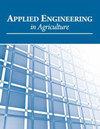Wood Pellet Production with the Inclusion of Rice Hull Derived Bio-oil
IF 0.9
4区 农林科学
Q4 AGRICULTURAL ENGINEERING
引用次数: 0
Abstract
Highlights Inclusion of heavy bio-oil (0.5%) improved pellet PDI by 0.4 percentage points when compared to the control. Inclusion of heavy bio-oil (0.5%) improved the HHV by 0.4 MJ kg-1 when compared to the control. Inclusion of heavy bio-oil (at 0.3% and 0.5% levels) improved the NPV over the control by $279K and $959K, respectively. Abstract.Rice hulls or husks have the potential to aid in wood pelletization as they possess high calorific values. However, this material also has a high ash content and is therefore not viable to be of use in the pelletization process without modification. This study focuses on using rice hull-derived bio-oil from pyrolysis, which decreases the overall ash content when compared to the original rice hulls and was postulated as a means to improve wood pellet characteristics (e.g., pellet durability index and the calorific value). Two groups of rice hull-derived bio-oil were used as an additive in wood fiber pelletization: Group 1 consisted of heavy bio-oil (products with a distillation vapor temperature only above 100°C) at a 0.2% (H2) and 0.5% (H5) additive inclusion rate (dry basis) with a matched control group (C1), and Group 2 consisted of bio-oil with light keys (products with a distillation vapor temperature of 20°C to 95°C and above 100°C) added from distillation process at a 0.2% (L2) and 0.5% (L5) concentration (dry basis) with a matched control group (C2). The C1, H2, H5, C2, L2 and L5 treatments had a mean pellet durability index (PDI) of 97.6%, 97.7%, 98.0%, 98.2%, 98.2%, and 98.3%, respectively. The C1, H2, H5, C2, L2, and L5 treatments had average bulk density values of 683.2, 678.4, 678.4, 673.6, 687.2, and 681.6 kg m-3, respectively. The mean higher heating values (HHV) for the C1, H2, H5, C2, L2, and L5 treatments were 24.6, 24.8, 25.0, 24.0, 24.0, and 24.0, MJ kg-1, respectively. The normalized energy requirements for production for the C1, H2, H5, C2, L2, and L5 treatments were 105.7, 96.3, 96.7, 97.9, 97.4, and 93.2 kWh Mg-1, respectively. An economic feasibility analysis showed that the discounted net present value (NPV) at a rate of 12% could be improved when using the H2 and H5 additives when compared to the control. Keywords: Biomass, Bio-oil, Hull, Husk, Pelletization, Pellets, Rice, Wood.含稻壳生物油的木屑颗粒生产
与对照组相比,加入重质生物油(0.5%)可使颗粒PDI提高0.4个百分点。与对照组相比,加入重质生物油(0.5%)可使HHV提高0.4 MJ kg-1。与对照组相比,加入重质生物油(0.3%和0.5%)分别使NPV提高了27.9万美元和95.9万美元。摘要稻壳或稻壳具有帮助木材颗粒化的潜力,因为它们具有高热值。然而,这种材料也有很高的灰分含量,因此不经改性不能用于造粒过程。本研究的重点是使用热解稻壳衍生的生物油,与原始稻壳相比,它降低了总体灰分含量,并被认为是改善木屑颗粒特性(例如,颗粒耐久性指数和热值)的一种手段。以两组稻壳源性生物油作为木材纤维颗粒化的添加剂:第1组是添加浓度为0.2% (H2)和0.5% (H5)的重质生物油(蒸馏蒸汽温度仅高于100℃的产品)(干基),并与对照组(C1)相匹配;第2组是添加浓度为0.2% (L2)和0.5% (L5)的轻质生物油(蒸馏蒸汽温度为20°C至95°C和100°C以上的产品)(干基),并与对照组(C2)相匹配。C1、H2、H5、C2、L2和L5处理的平均球粒耐久性指数(PDI)分别为97.6%、97.7%、98.0%、98.2%、98.2%和98.3%。C1、H2、H5、C2、L2和L5处理的平均容重分别为683.2、678.4、678.4、673.6、687.2和681.6 kg m-3。C1、H2、H5、C2、L2和L5处理的平均高热值(HHV)分别为24.6、24.8、25.0、24.0、24.0和24.0,MJ kg-1。C1、H2、H5、C2、L2和L5处理的标准化能量需求分别为105.7、96.3、96.7、97.9、97.4和93.2 kWh Mg-1。经济可行性分析表明,与对照组相比,添加H2和H5添加剂可提高12%的贴现净现值(NPV)。关键词:生物质,生物油,壳,壳,颗粒,颗粒,大米,木材。
本文章由计算机程序翻译,如有差异,请以英文原文为准。
求助全文
约1分钟内获得全文
求助全文
来源期刊

Applied Engineering in Agriculture
农林科学-农业工程
CiteScore
1.80
自引率
11.10%
发文量
69
审稿时长
6 months
期刊介绍:
This peer-reviewed journal publishes applications of engineering and technology research that address agricultural, food, and biological systems problems. Submissions must include results of practical experiences, tests, or trials presented in a manner and style that will allow easy adaptation by others; results of reviews or studies of installations or applications with substantially new or significant information not readily available in other refereed publications; or a description of successful methods of techniques of education, outreach, or technology transfer.
 求助内容:
求助内容: 应助结果提醒方式:
应助结果提醒方式:


